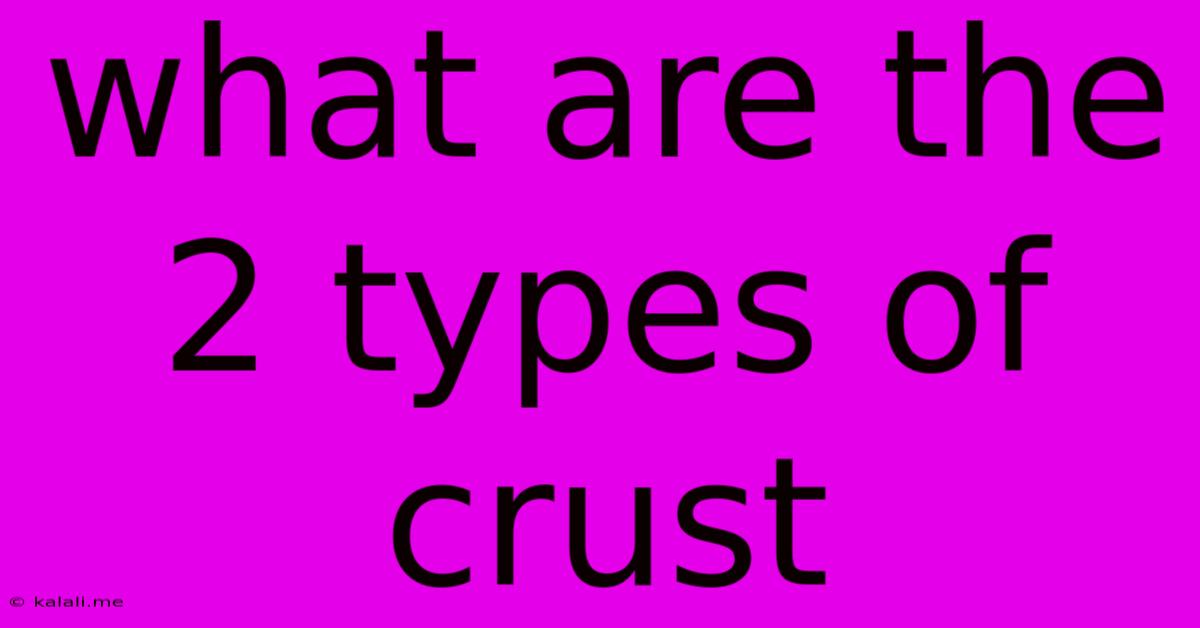What Are The 2 Types Of Crust
Kalali
Jun 06, 2025 · 3 min read

Table of Contents
What are the Two Types of Earth's Crust? A Deep Dive into Oceanic and Continental Crust
The Earth's crust is the outermost solid shell of our planet, a relatively thin layer compared to the mantle and core below. Understanding its composition and properties is crucial to grasping plate tectonics, volcanism, and the overall geological history of Earth. While the crust is diverse in its local characteristics, it's broadly categorized into two primary types: oceanic crust and continental crust. These two types differ significantly in their thickness, density, composition, and age.
Oceanic Crust: The Younger, Denser Sister
Oceanic crust underlies the ocean basins, covering approximately 70% of the Earth's surface. It's considerably thinner than continental crust, typically ranging from 5 to 10 kilometers in thickness. Its primary composition is basalt, a dark-colored, igneous rock rich in iron and magnesium. This gives oceanic crust a higher density compared to its continental counterpart, causing it to sit lower in the Earth's mantle.
- Formation: Oceanic crust is constantly being created at mid-ocean ridges through a process called seafloor spreading. Magma rises from the mantle, cools, and solidifies, forming new oceanic crust that pushes older crust outwards. This process is a key component of plate tectonics.
- Characteristics: Relatively young, dense (around 3.0 g/cm³), mafic in composition (high in magnesium and iron), and rich in iron oxides which gives it a darker color. It is also relatively uniform in composition compared to the continental crust.
- Recycling: Unlike continental crust, oceanic crust is constantly being recycled through subduction. At convergent plate boundaries, where oceanic plates meet continental plates, the denser oceanic crust is forced beneath the continental crust, melting back into the mantle.
Continental Crust: The Older, Lighter Companion
Continental crust forms the continents and continental shelves. It's significantly thicker than oceanic crust, ranging from 30 to 70 kilometers in thickness, with some areas even exceeding 100 kilometers. Its composition is more diverse and less dense (around 2.7 g/cm³) than oceanic crust. It's primarily composed of granite, a lighter-colored, igneous rock rich in silicon and aluminum, along with other felsic rocks like andesite and rhyolite. This lower density allows continental crust to float higher on the mantle.
- Formation: Continental crust is formed through a complex process involving volcanic activity, sedimentation, and metamorphism over billions of years. Unlike oceanic crust, it is not constantly being renewed. Parts of continental crust are among the oldest rocks on Earth.
- Characteristics: Older, less dense, felsic in composition (high in silica and aluminum), more variable in composition, and less uniform in thickness. It is generally lighter in color due to its mineralogical composition.
- Recycling: While some continental crust is recycled through subduction, it is far less susceptible to this process than oceanic crust. Much of it has persisted throughout Earth's history, bearing witness to ancient geological events.
Key Differences Summarized:
| Feature | Oceanic Crust | Continental Crust |
|---|---|---|
| Thickness | 5-10 km | 30-70 km (up to 100+ km) |
| Density | Higher (around 3.0 g/cm³) | Lower (around 2.7 g/cm³) |
| Composition | Basalt (mafic) | Granite (felsic) and others |
| Age | Relatively young | Relatively old |
| Recycling | Frequent subduction | Less frequent subduction |
Understanding the differences between oceanic and continental crust is fundamental to comprehending plate tectonics and the dynamic processes shaping our planet. The contrasting properties of these two crustal types drive many geological events, from the formation of mountain ranges to the occurrence of earthquakes and volcanic eruptions.
Latest Posts
Latest Posts
-
I Love That For You Meaning
Jun 07, 2025
-
Can You Stack Plus 4 In Uno
Jun 07, 2025
-
What Is A Theme For Darkness And Light
Jun 07, 2025
-
How To Find Dirt On Someone
Jun 07, 2025
-
How To Clean Vinyl Siding Without Scrubbing
Jun 07, 2025
Related Post
Thank you for visiting our website which covers about What Are The 2 Types Of Crust . We hope the information provided has been useful to you. Feel free to contact us if you have any questions or need further assistance. See you next time and don't miss to bookmark.